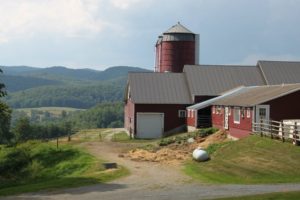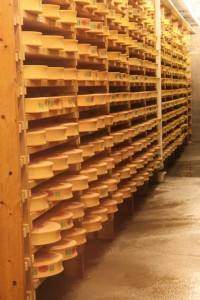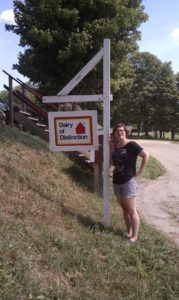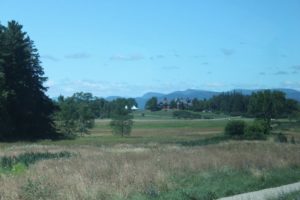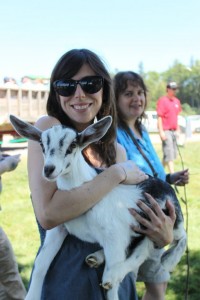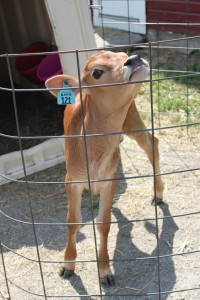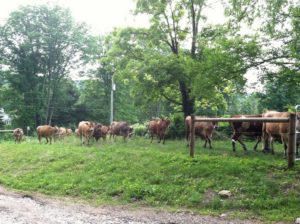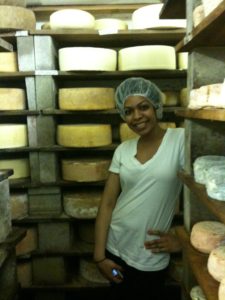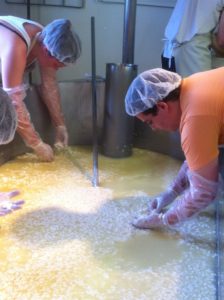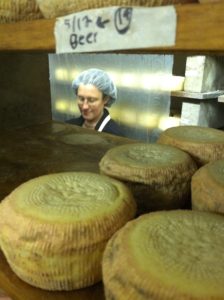
by Tim Erdmann
There isn’t too much that can draw me out of my apartment at seven o’clock on a Saturday morning. Promises of coffee and the cheese adventure of a lifetime, however, made this Saturday a little different. I, and 34 like-minded cheese adorers, arrived to Murray’s bright and early, eager to journey to the second annual Vermont Cheesemaker’s Festival. We were beaming. The sun was, well, not. Likely on an errand, we hoped it’d return soon. Goodie bags, bagels, and coffees in hand, we set out into the northern morning.
It was around the point where 17 meets I-87 that I think we all began to notice our new terrain. The color palette had shifted dramatically: our urban grays changed in favor of new greens and blues, the topography likewise ruffled and varied. The consideration of our environment could not have been more appropriate as we pulled into our first stop, The Farmer’s Diner in Middlebury, VT. Tired of the commercial food scene, the diner purchases as much as possible from local farmers. They are currently spending an impressive 83 cents to the dollar on products from within 70 miles, all ingredients with only the most enviable pedigrees. Greeted with Raspberry Sangria by Chef Denise, we were honored to celebrate their mission. While she delivered us a four-course feast and we quieted our stomachs, we heard from the local and charismatic cheesemaker Steve Getz of Dancing Cow Farm in Bridport, VT. It was an excellent taste of what was to come.


With satisfied bellies and happy spirits, we rejoined at the bus. Driver, and whey-cation alumnus, Sylvester adeptly maneuvered us across a beautiful mountain range to our next stop, the Vermont Butter & Cheese Creamery in Websterville, VT. Seemingly joined by fate, cheesemakers Allison Hooper and Bob Reese pioneered the company in 1984. Though it’s hard now to imagine Vermont without its artisanal cheeses and locavore ethics, the pair started as dairy mavericks. Allison was even so bold as to foresee Vermont as cheese’s Napa Valley. Today, their spirit is just as alive, and their approach to production has barely changed, except for maybe a little more cows’ milk and fancier gadgetry on site. Wearing lab coats, hairnets, and protective booties, we played cheesemakers for a day as we toured the drying room, laboratory, production spaces, and churning room. Even more impressed by the cheesemaker’s duties, we gathered again to taste the final products, the little gems that quietly explain why it’s all worth it.


After we checked in to the hotel, which boasted a pool, sauna, and all the luxuries due a proper cheese lover, we found ourselves at the festival’s kick-off cookout. Shelburne Vineyards hosted the night, and naturally, we were invited to tipple on the property’s wines and other local brews. A light drizzle and a local band made the soundscape as we lined up to get one of Marc Druart’s delicious burgers. As the Murray’s crew gathered to sit and eat on the grass, I realized that it was one of those iconic summer moments that I will treasure for the rest of my life. As the night closed, we made our way back to the hotel. Though we were all tired from a busy day well spent, I don’t think any of us could temper the excitement stirring for the coming day.


At last, the time had come. In spite of all of our anticipation, I don’t think anything could have prepared us for the beauty of Shelburne Farms. The 1400+ acre estate sits on the shores of Lake Champlain, with silhouettes of the Adirondacks finishing the landscape. The farm’s buildings and stables are veritable agricultural castles. Built in 1886 by Lila Vanderbilt Webb, and William Seward, the estate – now also an inn, nonprofit, and restaurant – maintain a presence of another time, where the relationship to the land is reciprocal and tender. Few communities that can mirror that sentiment like the producers of Vermont.
The festival’s arrangement was notably casual. We entered through a large tent housing old friends and new, tables running the spectrum from Cabot to the Vermont Cheese Council. One of the most surprising was a producer offering local ice cider (Eden Ice Cider Co.), made in the style of the famous and luxurious ice-wines. At least a few Murray’s employees escaped with a bottle or two. After the tent, the rest of the producers were set up in long great halls within the permanent structures of the farm. In total, there were 50 cheesemakers, 20 wineries and breweries, and 15 other artisanal producers, all of whom offering generous and wonderful samples. In case our palates needed a rest, there were a few seminars and demos to distract the mind, not to mention the entire estate grounds to explore. Any of us could have spent days at the festival, but alas all things must end. With goodie bags refilled, souls rejuvenated, and perhaps some career-paths drastically altered, we boarded the bus for the long return home, already looking forward to next year.


